
HERNIA(S) IN DOGS
A list of causes, types, prevention, diagnosis, and treatment options for hernias in dogs
Case History;-
On February 15, 2023, we received a case at SUPERIOR ANIMAL CLINIC of a 2-year-old terrier cross ’’BLACKIE’’ with swelling on the right side of the abdominal region next to the penis. The story goes:
Owner: Greetings doctor, I have brought my pet in for veterinary care as he is suffering from an abscess near his penis that has developed over the past two weeks. I need it drained for him to be fine and comfortable.
Vet Doctor: Hello madam, Thanks for your care for our furry friend. First, we shall do a checkup. Once the diagnosis is conclusive, there will be no more tests required.
Blackie’s checkup results:
Rectal temperature 38.2 °C, heart rate 130 bpm, respiratory rate 28 bpm, pale mucous membranes, swollen prescapular lymph nodes; On aspiration of the swelling, no pus was found; the swelling would disappear if gently pressed; and when Blackie sleeps on his back.
The doctor on duty diagnosed a reducible inguinal hernia.
After discussing the results with the owner, Dr. Mercy was told that the guard had kicked Blackie in the stomach region. The owner consented to surgery, which was a success. Blackie is now living a happy life.
Hernias in dogs: This is the abnormal protrusion of the internal body organ(s) through an opening created in a weak point in the wall containing the organ(s).
Types of hernias in dogs:
Hernias are mainly classified according to their location on the body, their reducibility, and their cause. But mostly location
Umbilical hernia in dogs: Occurs when an internal organ or intestine bulges through the navel.
Perineal hernia in dogs: Occurs when an internal organ(s) herniate into the subcutaneous tissues of the perineal region.
Inguinal hernias in dogs: Occurs when the internal organs (s) herniate through a weak point of the abdominal muscles into the inguinal region.
Diaphragmatic hernia in dogs: The internal organ(s) herniate through the diaphragm muscles into the chest cavity.
Incisional hernia in dogs: The internal organ(s) protrude through the surgical site.
How did my dog get hernia?
Causes of hernias in dogs
Trauma
Genetic disorders
Excessive weight gain
Constipation
Cancer of the internal organs
Ascites
Cryptorchidism
Pregnancy
Poor closure or infection of the surgical site
Rupture of the stitches at the surgical site
Excessive chronic cough
Pulling of heavy materials by sled dogs
How do I know if my dog has hernia?
The symptoms manifested depend on the severity and nature of the hernia. The signs include:
Abnormal bulge that can be either reducible or irreducible on pressing
Vomiting
Breathing difficulties
Coughing
Anorexia
Paralysis of the limbs
Abnormal posture and gait
Fever
Constipation
Weight loss
Lethargy
Bloody emesis or diarrhea
Swollen abdomen
Drooling
Dogs lay in positions where they feel pain relieved (where the protruded organs get retracted to their original positions, but this is possible for only reducible hernias).
What happens if I do not treat my dog for hernia?
If the hernia is left untreated, your dog will experience complications that vary depending on the type of hernia your dog has.
Pneumonia
Peritonitis
Ascites
Intestinal strangulation
Emaciation
Ulcers
Intestinal adhesions
Paralysis of the limb
Intestinal necrosis
Intestinal obstruction
Unthriftiness
Hydrothorax
How can I prevent my dog from getting hernias?
Avoid inbreeding
Do not breed dogs with congenital hernias.
Avoid strenuous exercises and the pulling of heavy materials by sled dogs.
Proper care for the surgical site.
Dogs should be fed soft food.
Proper food ration.
Neutering.
Do not mate small female dog breeds with large male dog breeds.
How to diagnose hernias in dogs
Physical palpation: abnormal swelling is felt that can disappear on pressing if reducible but remain if irreducible.
X-rays: the filming shows the location and extent of the hernia.
CT scans are used to discover small hernial tears.
How to treat hernias in dogs
The remedy plan depends on the size of the hernial ring, location, clinical signs manifested by the dog, and whether they are reducible or irreducible. They include:
Surgical closure of the hernial opening: large hernial openings require a mesh that is put over which muscles heal.
If the hernial opening is small and the contents are reducible, it may resolve independently.
Administer broad-spectrum antibiotics and anti-inflammatory medications.
Give anti-emetics and anti-diarrheals.
Give IV fluids for cases involving dehydration and anorexia.
Conditions commonly confused with hernia
Tumors
Abscess
Hematomas
Swollen lymph nodes
Sebaceous cysts, mainly in the abdominal region
Localized severe cellulitis
Since most dog hernias are congenital, choosing breeding parents should be done with greater care.
Contact us call / WhatsApp +256771909946 for free consultations on the current state of your pet
Don’t forget to read the related posts below and share them with other responsible pet owners.
causes and treatment of hair loss in cats
Deworming schedule for puppies and adult dogs
What can I do to help my dog live longer?
Read about cataracts or cloudy eyes in cats
vaccination schedule for cats in Uganda
21 Questions to Ask Yourself Before Getting or Adopting a Dog
Read about the 5 killer diseases for dogs in Uganda
Vaccination schedule for dogs (puppies) in Uganda
Read about the causes and treatments of vomiting among dogs
Read about the cost of treating a dog in Uganda
Read about if humans can get parvo
Get know if teething can kill a puppy
Read about how puppies get parvo
Find the best treatment for parvo in dogs.
Read about the price of spaying a dog in Uganda
Read about the prices of vaccinating a dog in Uganda
Read about the price of parvo treatment in Uganda
Read about the treatment of intestinal adhesion in dogs.
Read about the causes and treatment of hernias in dogs.
Read about the causes and treatment of weight loss in dogs.
Read about the loss of hair in dogs.
Read about the causes and treatment of bad breath in cats.
Read about 10 simplified steps for grooming a pet.
Learn the 8 steps of trimming the nails of your dog.
Read the causes of scratching in dogs.
Read the causes and treatment of ear infections in dogs.
Read the causes, prevention, and treatment of bloat in dogs
Reab about the causes and treatments of curled toes in turkeys
Read about causes and treatment of cancers in dogs
Vaccination schedule for dogs (puppies) in Uganda
